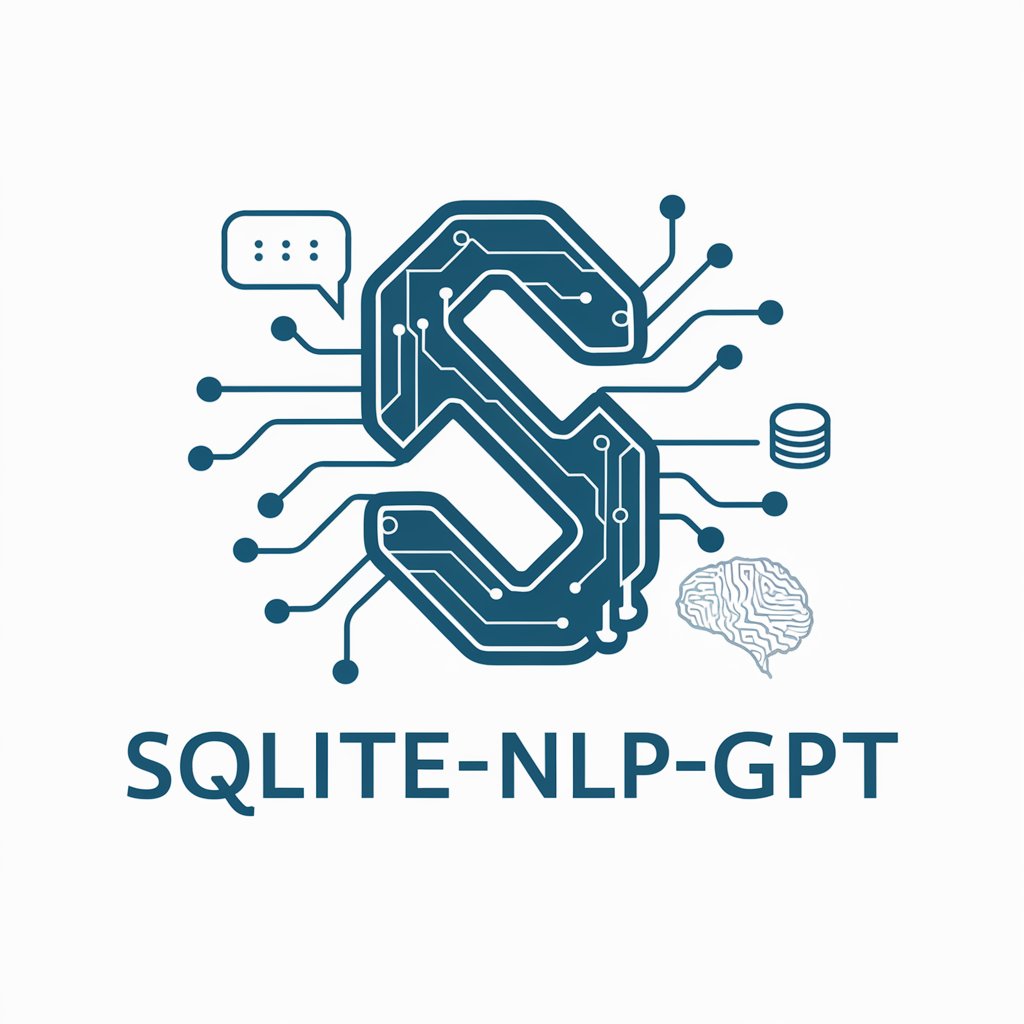
SQLite - AI-powered database assistant

Advanced SQLite assistant and query generator
AI-powered database management made simple
✏️ Design a full db schema for a to-do app
👨🏽💻 Write some example queries in SQLite
⚡️ Optimize this SQLite query and fix errors
🧠 Teach me some useful skill or trick in SQLite
Get Embed Code
Introduction to SQLite
SQLite is a lightweight, serverless, self-contained SQL database engine. Unlike other SQL databases, SQLite does not require a separate server process to operate; instead, it reads and writes directly to ordinary disk files. It’s widely used in embedded systems, mobile devices, and applications where a low-resource, simple, yet powerful database is needed. SQLite's design philosophy emphasizes simplicity, portability, and ease of use, making it ideal for applications that require a robust relational database without the overhead of a full database management system. For example, in mobile applications, SQLite is commonly embedded in iOS and Android apps to manage local data storage efficiently. Web browsers, like Google Chrome and Mozilla Firefox, use SQLite to store various types of data, such as browsing history and cached files. SQLite's design purpose revolves around these types of scenarios where quick, reliable, and low-maintenance data storage is necessary. Powered by ChatGPT-4o。

Key Functions of SQLite
ACID Compliance
Example
SQLite supports transactions that adhere to Atomicity, Consistency, Isolation, and Durability (ACID) properties.
Scenario
In a banking application, this feature ensures that all changes to the database occur in a reliable, consistent way. For example, transferring money from one account to another can be done atomically, meaning either both the debit and credit operations occur or none at all, preventing data inconsistency.
Self-Contained, Serverless Operation
Example
SQLite operates directly on files and does not need a separate server to manage connections.
Scenario
Consider a desktop application like an accounting tool that needs to store data locally on a user's machine without the complexity of setting up a database server. SQLite's serverless nature is ideal because it stores data directly in a file without requiring additional setup.
Full-Featured SQL Support
Example
SQLite supports a substantial subset of SQL, including JOINs, subqueries, views, and triggers.
Scenario
A small e-commerce website that stores product information, customer orders, and user profiles in a SQLite database can perform complex queries like fetching all orders for customers who have bought a specific product using SQL JOIN statements.
Cross-Platform Portability
Example
SQLite databases are portable across different operating systems, such as Windows, Linux, and macOS.
Scenario
A software company developing cross-platform desktop software can use SQLite for its local database needs. The same SQLite database file can be copied and used across different systems without modification.
Zero Configuration
Example
SQLite doesn't require configuration files or complicated setup processes.
Scenario
A data analysis script running in a Python environment can utilize SQLite to store intermediate analysis results without needing to configure a separate database system. This allows developers to get started immediately without the need for installation or administration.
Small Footprint
Example
The SQLite library is highly compact, typically under 1MB in size.
Scenario
In embedded systems, such as an IoT device tracking environmental sensor data, the small size of SQLite is crucial, as these devices often have limited memory and storage capacity.
Target Users of SQLite
Mobile Application Developers
Mobile apps often need a local database for storing user data, app settings, or caching information. SQLite is embedded in both iOS and Android operating systems, making it the go-to solution for mobile developers. Its small footprint and serverless architecture allow for efficient use of limited mobile resources while providing robust SQL functionality.
Embedded Systems Engineers
For engineers working on embedded systems, such as IoT devices or hardware products that require some form of local storage, SQLite's lightweight, serverless nature and small code footprint make it an excellent fit. It's commonly used in products like routers, GPS systems, and even home automation devices.
Web Developers
SQLite is frequently used in web browsers for local data storage and session management. Developers working on web applications can benefit from SQLite for storing small amounts of data on the client-side without requiring server-side database setup.
Data Analysts and Scientists
Data analysts who work with smaller datasets and need a reliable local database solution for testing, prototyping, or temporary data storage often choose SQLite for its ease of integration with programming languages like Python. It’s especially valuable for use cases that don't require a full database system but still need SQL-like functionality.
Software Developers Building Standalone Applications
Developers creating standalone desktop applications, such as accounting software, note-taking apps, or media players, often embed SQLite for managing user data. The serverless, zero-configuration nature of SQLite ensures that the application can be easily installed and used by end-users without requiring external dependencies.

Guidelines for Using SQLite
Step 1
Visit yeschat.ai for a free trial without login, no need for ChatGPT Plus. This allows you to quickly get started without any barriers.
Step 2
Download and install the SQLite command-line tool or SQLite browser for your operating system. This is the core tool you’ll need for database operations.
Step 3
Open the SQLite command-line interface or use a GUI like DB Browser for SQLite. Initiate a new database with the command: `sqlite3 database_name.db`.
Step 4
Create tables, insert data, and execute SQL queries using SQLite's SQL syntax. For example, use `CREATE TABLE` to create tables and `SELECT` to retrieve data.
Step 5
Save and manage your database files locally. SQLite databases are stored in a single file, making backups and transfers easy.
Try other advanced and practical GPTs
PDF Summarizer
AI-powered PDF analysis and summaries

Zappychat AI Prompt Generator
Create AI-powered chatbots for all tasks

Cargo Ship Captain
AI-powered maritime operations assistant.

ContaTech IA - Examenes de contabilidad/auditoría
AI-powered tool for accounting and audit exam solutions.

Blog PF & Editor
AI-powered editor for flawless writing

Chat with GPT 4o ("Omni") Assistant
AI-driven assistant for everyday tasks.

Jest Test Builder
AI-generated tests for smarter coding

Microphage-1
AI-driven writing for optimal UX

JSON
AI-powered JSON made simple

Dominant Girlfriend
AI-Powered Virtual Girlfriend for Playful Interaction

LaTeX
AI-powered LaTeX editor for professionals

Cố Vấn Nhân Sinh
AI-driven insights for life improvement

Common SQLite Q&A
What makes SQLite unique compared to other database systems?
SQLite is a serverless, self-contained, and lightweight relational database system. It operates directly on disk files, making it ideal for local applications, embedded devices, and smaller projects.
Can SQLite handle large databases?
SQLite can handle databases up to 281 terabytes in size. However, performance can degrade with extremely large datasets or high concurrency, where full-fledged database systems like PostgreSQL may be more appropriate.
How do transactions work in SQLite?
SQLite supports ACID-compliant transactions, ensuring that all operations within a transaction are either fully completed or fully rolled back. You can use `BEGIN TRANSACTION`, `COMMIT`, and `ROLLBACK` commands to manage transactions.
Is SQLite suitable for production environments?
Yes, SQLite is often used in production environments, particularly in mobile apps, embedded systems, and small-to-medium-sized applications. It’s ideal for situations where a simple, low-maintenance database solution is needed.
What are the limitations of SQLite?
While SQLite is powerful, it has limitations like lack of support for advanced features like user-defined roles, and its performance can decrease with high write concurrency or extremely large datasets. It is best suited for local, read-heavy workloads.





